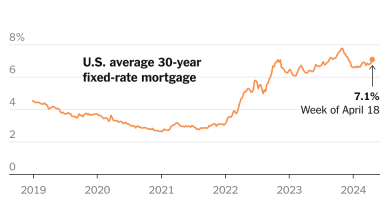G.E. to Break Up in Latest Effort to Revive an Iconic Company

General Electric, the iconic industrial corporation of the late 20th century, once a powerful conglomerate renowned for its management prowess, is making a final break with its storied past.
The 129-year-old company announced on Tuesday that it planned to split itself into three publicly traded businesses, a remarkable change at a company whose reach into American life once extended from light bulbs in the home to the engines on jet airplanes.
In a conference call with analysts, H. Lawrence Culp, an outsider brought in as chief executive three years ago, described the planned breakup as a “defining moment” for G.E. and the culmination of his effort to remake it as a “more focused, simpler, stronger high-tech industrial company.”
G.E.’s plan is to spin off its health care division in early 2023 and its energy businesses a year later. That would leave its aviation unit as its remaining business, which would continue to be led by Mr. Culp.
In speaking to analysts, Mr. Culp also portrayed the move as being in step with the times, as other industry conglomerates have streamlined. The spinoff plan, he said, “heightens focus and accountability” and “just makes everybody better.”
Industrial conglomerates have fallen somewhat out of favor. In the last few years, G.E.’s big German rival Siemens has spun off its health care and energy businesses. And Honeywell International, another wide-ranging industrial company, has sold off some operations. But none have undergone as drastic an overhaul as G.E. has planned.
In its heyday, the G.E. corporate empire was fueled by rising profits. For years, it used that money to expand into new businesses. It owned NBC, powered locomotives and developed medical imaging technology. Its complexity was a part of the company’s pitch to investors.
G.E. also manufactured executives. The company became a training ground for them, creating a growing cadre of star managers. They were selected, trained and moved from one business to another every few years.
Ambitious young people flocked to the company to work there whether for a long career or for just a few years. Former managers at G.E. held top leadership roles at many American companies.
But in some ways, the fall of the company came because of mismanagement. Under Jack Welch, its leader for two decades until 2001, G.E. built up a huge finance arm. The assumption was that G.E.’s managers were the best in the world, and there was easy money to be made on Wall Street.
The buildup backfired when the financial crisis hit in 2008, putting G.E. in a credit crunch. Its chief executive at the time, Jeffrey R. Immelt, moved to drastically pare back the big finance unit, GE Capital.
Other businesses hit hard times because of the financial crisis as well, and some Wall Street firms collapsed. But few outside of Wall Street are still paying a price like G.E. Struggles and surprises have continued in the financial business, and in a big power-generation business, which overexpanded and misread demand.
Over time, analysts say, size worked against the company, as bureaucracy sapped corporate agility.
“G.E. got caught in the past — and now it’s the end, it’s over,” said Scott Davis, chief executive of Melius Research, an independent financial analysis firm.
In 2017, John Flannery, a longtime G.E. manager, replaced Mr. Immelt. He quickly made it clear that he thought the era of giant conglomerates was over, saying that G.E. would become smaller and simpler. But the company’s issues persisted, and financial performance continued to disappoint.
In June 2018, G.E., the last original member of the Dow Jones industrial average, was dropped from the blue-chip index. By the fall of that year, Mr. Flannery had been forced out, replaced by Mr. Culp.
The company has also paid hundreds of millions to settle charges that it misled investors.
Cost-cutting accelerated under Mr. Culp. G.E., which had more than 300,000 employees worldwide in 2014, now has 161,000 workers.
Investors, including Trian, the shareholder activist firm led by Nelson Peltz, have pressured the company to spin out or sell various businesses, and they cheered the move on Tuesday.
“Trian enthusiastically supports this important step in the transformation of G.E.,” a spokeswoman for Trian said.
Shares of G.E. climbed more than 6 percent in early trading Tuesday.
This is a developing story. Check back for updates.




